The Nechung oracle is the state oracle of Tibet. The governing council of Tibet and the Dalai Lama consult him on all matters of state. Usually, it is the chief minister of the Dharma Protector Pehar by the name of Dorje Drakden who takes possession of the oracle and acts as the mouthpiece for Pehar.
The Horpas, an ethnic group that lived east of the Kokonor Lake, originally worshiped Pehar. According to oral tradition, this deity was one of the many deities and powerful spirits that challenged Guru Padmasambhava when he first came to Tibet. Consequently, he was subjugated and sworn to protect the Dharma. According to another source, a Bön (indigenous shamanistic tradition of Tibet) general by the name of Tara Lugong brought back the worship of this deity when he seized a meditational center near Kanchow of the Bhata Hor, a tribe of Uighurs, towards the end of the 8th century CE.
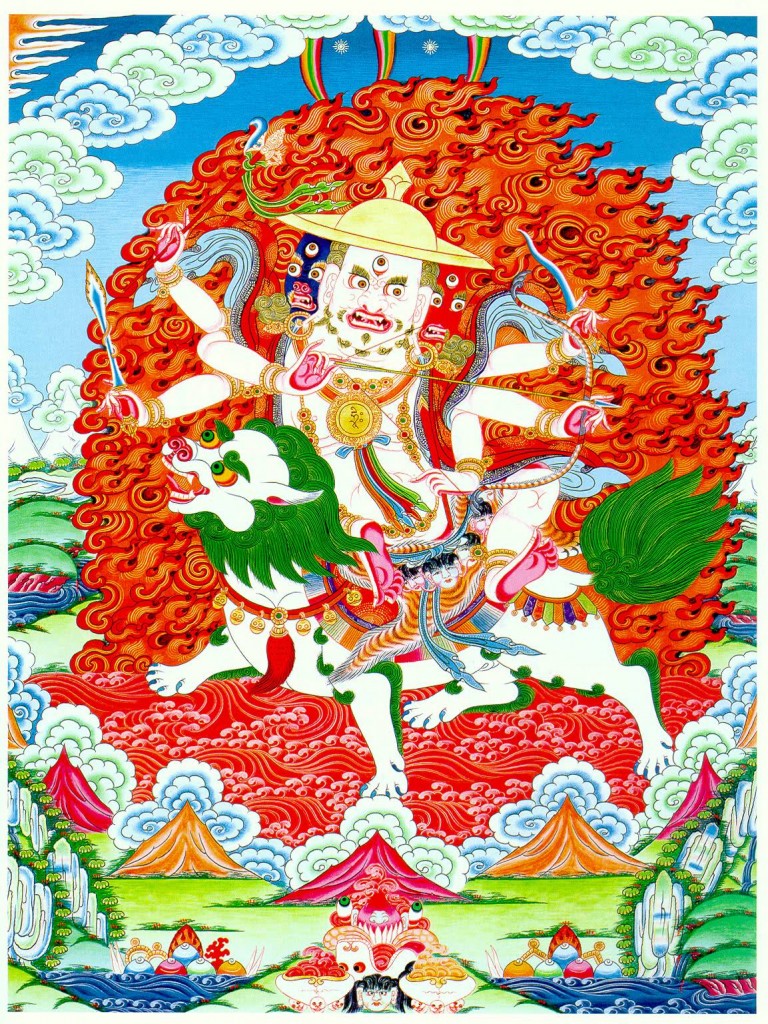
A thangka representation of Nechung Pehar
Pehar was the protector of Samye Monastery and also a protector of the Dharma in general. During the time of the Fifth Dalai Lama (1642-1682), the worship of Pehar first moved from Samye to Tse Gungtang and then to the present site of Nechung Monastery. At Tse Gungtang, Pehar was believed to have started a fire at a monastery. This angered a powerful high lama there who, using his meditational powers, captured Pehar in a box and threw him in a river.
This box floated westwards into the vicinity of Drepung Monastery, where an abbot requested an attendant to retrieve it. While the attendant was carrying the box back to the monastery, he opened the box out of curiosity. Pehar, in the form of a bird, escaped and perched upon a nearby tree before disappearing. It was around this tree that a chapel was later built to Pehar. The Fifth Dalai Lama expanded this chapel which later became known as Nechung Monastery. Then, he installed the Nechung oracle as the state oracle of Tibet.
In spite of holding the respected position of state oracle, the Nechung oracle over the centuries has been beset with numerous controversies. Hence, many high lamas both in the past and today refuse to consult the Nechung oracle even on the smallest of matters as this oracle has been proven to give inaccurate pronouncements and prophecies over the years.
During the time of the Fifth Dalai Lama
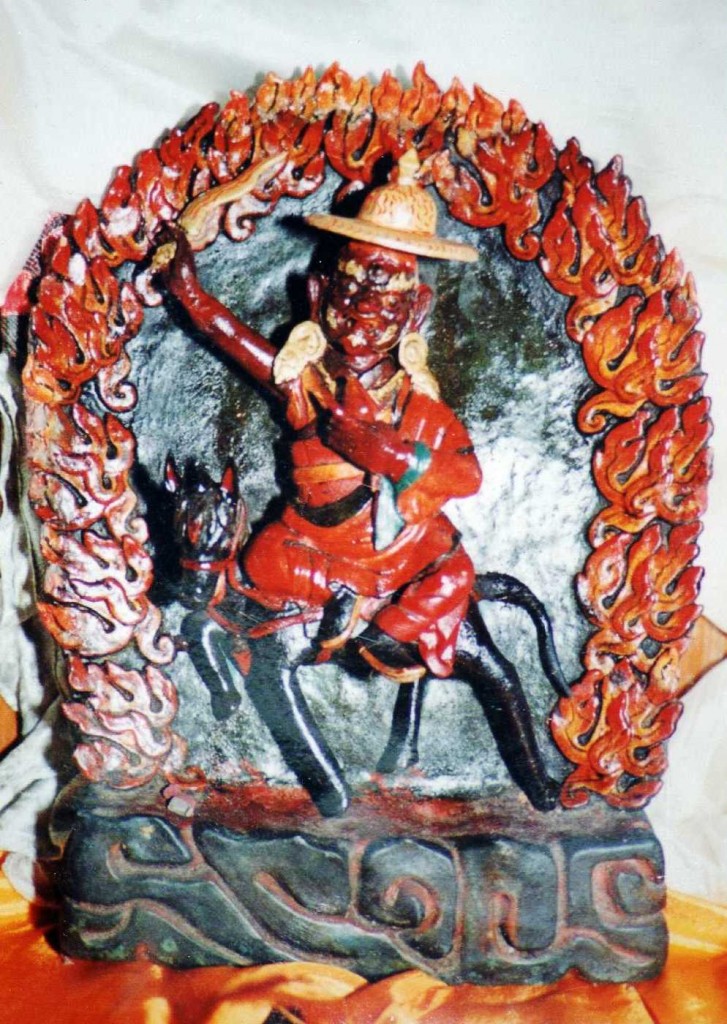
A statue of Dorje Shugden riding on a horse that was believed to have been made by the Fifth Dalai Lama
It is generally believed that the current Dorje Shugden ban was substantiated by a long-standing feud that extends back to the time of the Fifth Dalai Lama, who had initially blamed the calamities befalling Lhasa at the time on the spirit of the deceased lama, Tulku Drakpa Gyeltsen.
The Fifth Dalai Lama commissioned Nyingma lamas to perform powerful fire pujas to eradicate the ‘spirit’, Dorje Shugden. However, the pujas were ineffective as Dorje Shugden was of the same indestructible nature as Yamantaka. The Dalai Lama realized this and composed a praise to Dorje Shugden, built the shrine Trode Khangsar and crafted statues according to the vision he had of Dorje Shugden. According to the elder monks of Gaden Phelgyeling Monastery, the Fifth Dalai Lama was the one who appointed Dorje Shugden to be the protector of their monastery as well. Thus, whatever issues that might have existed between Dorje Shugden and the Fifth Dalai Lama were resolved. Since then, many Dalai Lama incarnations have arisen with no issues with Dorje Shugden.
During the time of the 13th Dalai Lama
It is believed that issues with Dorje Shugden resurfaced during the time of the 13th Dalai Lama but historical records reveal the truth of the matter – that he merely reshuffled state approval of deities. At that time, Tibetan society was rife with the worship of innumerable deities and oracles. Charlatans had taken advantage of the situation, posing as oracles of make-believe deities and cheating people of money and offerings.
To curb the situation, the 13th Dalai Lama outlawed the worship of a number of such deities and oracles. On the other hand, the Dalai Lama continued to approve of the state oracles of Nechung and Gadong, Dorje Shugden from Trode Khangsar, Tsangpa (believed to be the peaceful aspect of Setrab) and the Tenma oracle from Drepung.
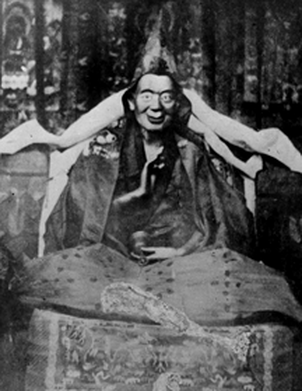
The embalmed holy remains of Domo Geshe Rinpoche Ngawang Kelsang (1866-1936) – the only known image of him
There was a high-ranking police officer for British India by the name of Legden. He was a Sherpa (of Tibetan ethnicity) from Darjeeling, and had maintained special relations with the 13th Dalai Lama. He often traveled to Tibet and was bestowed a high rank by the Dalai Lama for being the founder of the first Tibetan police regiment in Lhasa. On one occasion, he was requested to investigate a money-forgery racket by the Dalai Lama and was successful in arresting several Nepalese men in Calcutta who were involved in this racket. He was also awarded medals of honor by the British government in London for his service in India.
His memoirs include a personal letter from the 13th Dalai Lama thanking him for his service to Tibet, and several gifts including a walking stick. The Dalai Lama also gave him some special sacred items which were to be sent to a modern temple of Dorje Shugden as well as a Guru Rinpoche temple, both founded by Domo Geshe Rinpoche.
The above are some noteworthy anecdotes that confirm the 13th Dalai Lama had actually approved of the worship of Dorje Shugden, contrary to what is disseminated today.
Younghusband British invasion and the demise of the 13th Dalai Lama
The Nechung oracle is infamously linked to the defeat of the Tibetans at the hands of the British expedition in 1904. Prior to this, the Tibetans had taken measures to curb the growing influence of the British in the Sikkim area. On the advice of the Nechung oracle, the Tibetans forcibly occupied a mountain within the influence of the British. The Nechung oracle said that the magical powers emanating from the mountain would fend off the advance of the British troops into Tibet. Needless to say, the British forces recaptured the mountain fairly easily with a feeble resistance from the Tibetans.
Then in 1904, the Younghusband Expeditionary Force began to advance into Central Tibet after a failed negotiation attempt. Colonel Francis Younghusband led the British troops into the Tibetan heartland. The Nechung oracle was invoked and proclaimed that the British army would reach Central Tibet and predicted that the Tibetan army would be victorious. The British did arrive in Lhasa but, unlike Nechung’s prophecy, easily defeated the poorly equipped Tibetans. The Dalai Lama fled the country along with the Nechung oracle. Upon his return when the had British departed, the Nechung oracle was dismissed from his position as the state oracle.
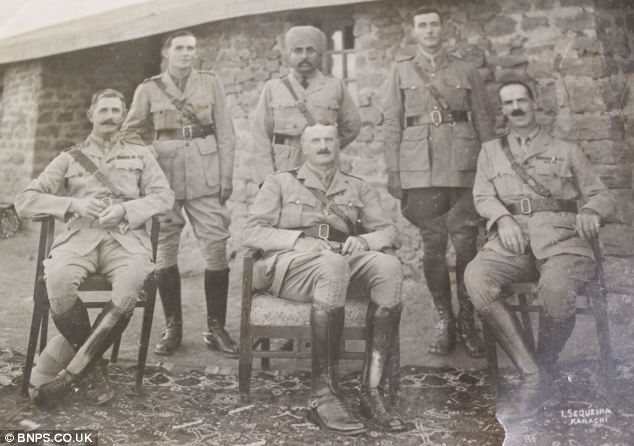
Expedition leader Col Younghusband (centre) with Captain Hayman (right) and other officers in Tibet in 1903
When the 13th Dalai Lama fell ill, the Nechung oracle was traditionally invoked to advice on the best course of action to heal the Dalai Lama. Towards the end of the 13th Dalai Lama’s days, the Nechung oracle was summoned whereupon he prescribed a certain herbal remedy and prepared the medicine in a cup of water himself.
Witnesses said that the 13th Dalai Lama refused to drink the concoction but the Nechung oracle insisted and literally poured the tonic down the Dalai Lama’s throat. The Dalai Lama’s condition deteriorated after that and he soon lost consciousness and never said another word. It was said that the Dalai Lama was prescribed the wrong medicine for his condition and that was what killed the Dalai Lama.
It is widely believed that, since the time of the 13th Dalai Lama until today, the Nechung oracle has been under the influence of an evil spirit instead of Nechung/Pehar, thus causing much mischief and problems for the Tibetan peoples such as the untimely death of the 13th Dalai Lama. Some believe that a tulku of Nyarong who had become a raging spirit is entering the Nechung oracle. Another source claims that the Nechung oracle is taking trance of a previously deposed oracle. Whatever it is, rumors and controversy have been shadowing the Nechung Oracle ever since, not to mention glaringly wrong predictions and prophecies.
The 14th Dalai Lama’s escape from Tibet
The biography of the 14th Dalai Lama states that, during the tumultuous period of 1959, it was Nechung via his oracle who told the Dalai Lama that it was time to escape from Tibet. However, according to letters and documents from Changtso Lobsang Yeshe, it was in fact a message from Dorje Shugden that prompted the Dalai Lama to begin his flight to India. After the Chinese forces fired two cannon shots at the Potala Palace, Kyabje Trijang Rinpoche had requested Rato Chowar Rinpoche and Kensur Ngawang Dakpa of Sera Mey Monastery to consult the Panglung Oracle about the imminent threat to Tibet.
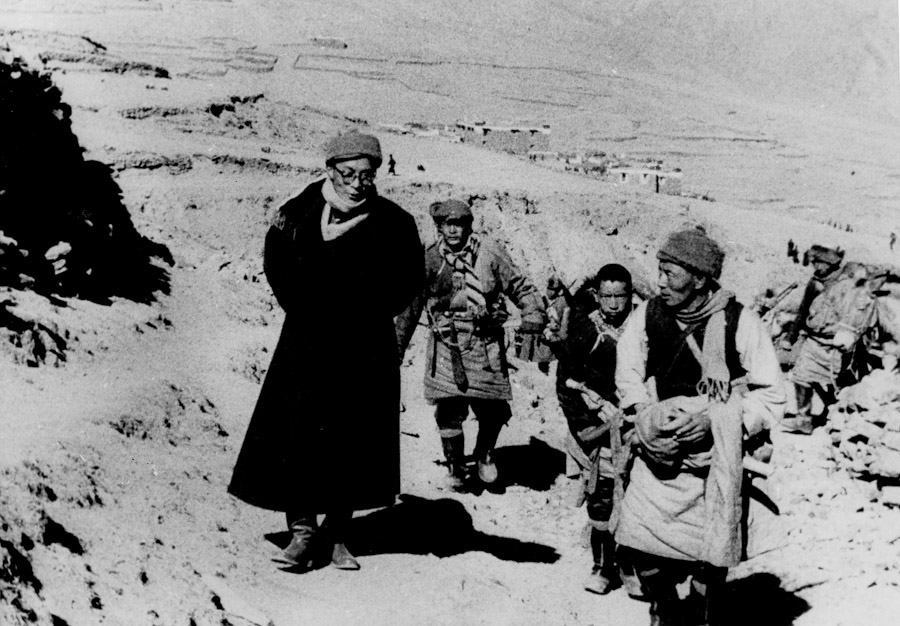
Changtso Lobsang Yeshe became the main intermediary between Kensur Ngawang Dakpa and Dorje Shugden via the 6th Panglung Oracle because the Chinese were observing Kensur Ngawang Dakpa rather tightly. Thus, it was Changtso Lobsang Yeshe who ended up representing Kensur Ngawang Dakpa at a private audience on this pressing matter with the Protector Dorje Shugden on 10th March 1959 via the 6th Panglung Oracle.
During that period, a sinister Chinese plot to have the Dalai Lama and many other religious leaders arrested and harmed was uncovered. And it was at this crucial juncture that Dorje Shugden gave specific advice for the Dalai Lama to leave Tibet without further delay. Dorje Shugden also specified the exact time and day of departure, the escape route, and also gave further instructions on what to do to ensure a successful escape. Conversely, the Nechung oracle had adviced the Dalai Lama to remain in Tibet.
Thus, the 14th Dalai Lama’s life and the spread of Tibetan Buddhism in the world is attributed to Dorje Shugden and not the Nechung oracle.
How Nechung misled the 14th Dalai Lama
In 1970, the 14th Dalai Lama was still practicing Dorje Shugden, exactly as he had been taught by His Holiness Kyabje Trijang Rinpoche. It was also widely known that the Dalai Lama had his personal monastery, Namgyal Monastery, perform monthly pujas to Dorje Shugden.
However, around the time when the Dalai Lama was about to receive Dorje Shugden sogtae or life-entrustment initiation from Kyabje Trijang Rinpoche, the state oracle took trance and misled him away from the practice with negative counsel about Dorje Shugden. Therefore, it is clear that the Dorje Shugden ban did not start from a vision or meditative realization but was influenced by an external source.
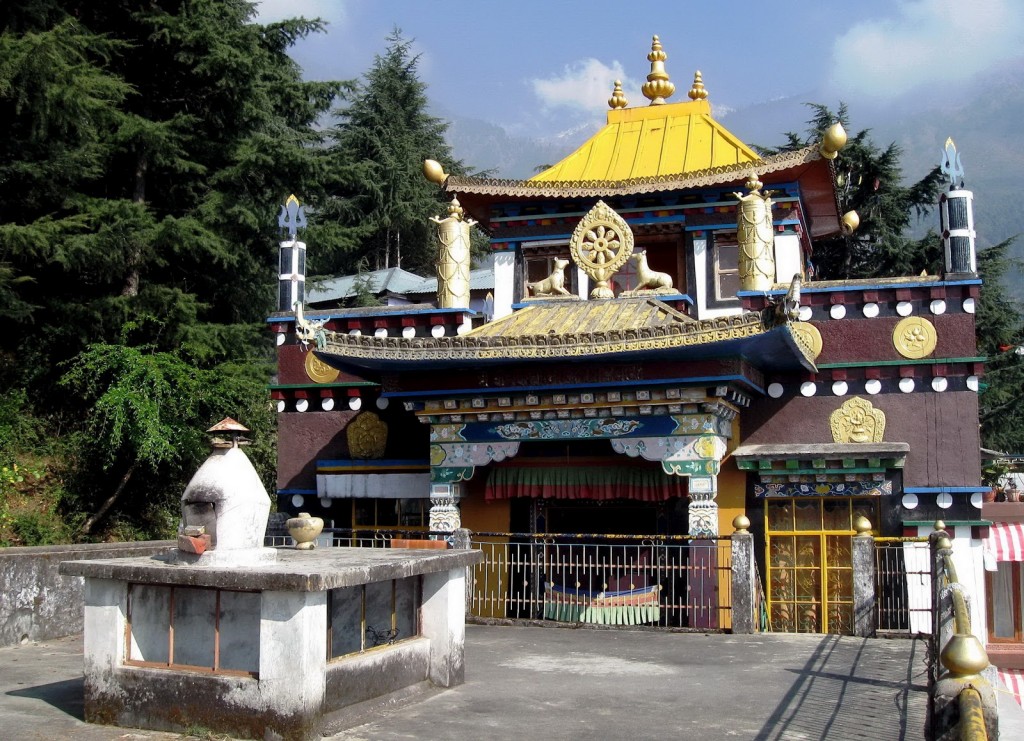
In the 70s before the ban, the Dalai Lama’s private Namgyal Monastery was doing monthly Dorje Shugden pujas
The Dalai Lama had two extraordinary gurus, Kyabje Ling Rinpoche and Kyabje Trijang Rinpoche. Of the two tutors, Kyabje Ling Rinpoche was the ‘father’ and Kyabje Trijang Rinpoche was the ‘mother’. Kyabje Trijang Rinpoche not only gave teachings on the Lamrim and other Dharma topics to the Dalai Lama but also taught everything else he knew from table manners to the proper etiquette expected of a high lama.
In fact, the Dalai Lama has received the most tantric transmissions and Lamrim teachings from Kyabje Trijang Rinpoche. Even Kyabje Ling Rinpoche received the Lamrim teachings from Kyabje Trijang Rinpoche. Thus, whenever the Dalai Lama gives lamrim teachings, he should recite the prayer to solicit the blessings of the lineage masters beforehand, according to tradition. However, due to the Dorje Shugden controversy, Kyabje Pabongka Rinpoche and Kyabje Trijang Rinpoche have been omitted from the list of lineage masters. This is a travesty of tradition and lineage – these two great masters are major lineage holders of the Gelugpa tradition and omitting them would mean that the lineage is broken.
Pisu Jola’s Book
Pisu Jola was an educated lay Tibetan man. He sponsored the Dorje Shugden statue in the great prayer hall of Gaden Tsokchen, which was consecrated by the Dalai Lama, the two tutors – Kyabje Ling Rinpoche and Kyabje Trijang Rinpoche, Kyabje Zong Rinpoche and other high lamas. However, when the ban on Dorje Shugden began, the Dalai Lama decreed that the statue was to be removed. Thus, the Gaden oracle had the statue placed in his own temple instead.
When Pisu Jola found out about this, he was very disturbed and pleaded with the religious affairs office not to carry out the plan. At that time, Nyingma Lama Kamtrul was the person in charge. Pisu Jola pleaded with him not to do so. He said,
I do not have a very long time to live. I do not want to die in such great disappointment…
In other words, he was very respectful. But the lama responded by admonishing the old man saying,
You stupid old man! If you are afraid of your death, you should listen to the Dalai Lama.
Disheartened by the state of affairs, Pisu Jola decided to write a small but powerful book about the Dorje Shugden issue. Guru Deva Rinpoche sponsored the publication of Pisu Jola’s book. The Central Tibetan Administration were very unhappy when the book began circulating, as it contained many true stories that they wished to suppress. So desperate were they, that the CTA even offered a reward for each copy of Pisu Jola book that was handed over to them!
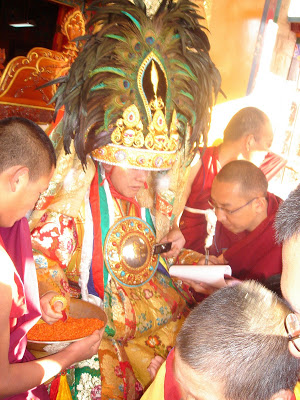
The Nechung Oracle in full regalia as he takes trance of Dorje Drakden who acts as a mouthpiece for Nechung
So what is all the fuss about? Well, one of the stories in Pisu Jola’s book is the famous story of the circumstances surrounding Kyabje Ling Rinpoche’s passing. When Kyabje Ling Rinpoche was seriously ill, Ling Ladrang (household), Changtzos (assistants) and the Abbot of Sera Mey Monastery at that time requested for an emergency trance with the Nechung oracle in order to consult the Dharma Protector Nechung for a way to heal Ling Rinpoche’s illness.
The paper containing the questions pertaining to Ling Rinpoche’s health was presented to Nechung in trance, who took it, crumpled it into a ball and put it under his buttocks. Nechung then proclaimed that if Ling Rinpoche’s condition improved in three days time, there would be no harm to Ling Rinpoche’s life. Nechung further commented,
Obstacles from the big is put on the head of the small.
This was interpreted to mean that the Dalai Lama’s obstacles (‘big’) were being suffered by Ling Rinpoche (‘small’). This statement got the old Ling Ladrang Changtzo worked up. “How can the Guru be considered the ‘small’ and the student the ‘big’?” the Changtso said.
The Ling Ladrang Changtzo grabbed Nechung in trance by his clothes and scolded Nechung to his face saying,
Every day we offer you liquor, tea and pray to you. And in difficult times like these, you say such things and never help!!!
Nechung left the body of the oracle and never took trance in the presence of the Changtzo again.
The Great Return to Tibet
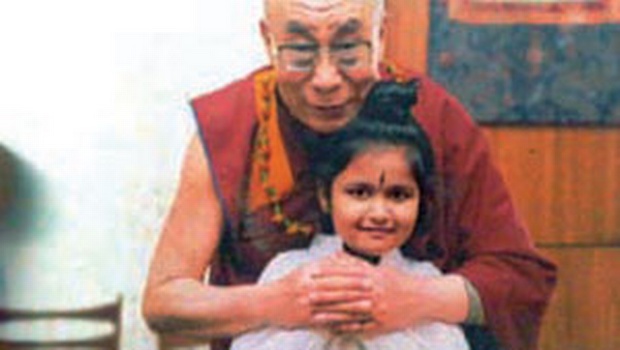
The Dalai Lama with the Indian beggar girl who claimed to be the incarnation of a Hindu goddess
In more recent times, an Indian beggar girl traveled to Dharamsala a few years ago claiming to be an incarnation of the Hindu goddess Sambhavi. Her parents demanded a private audience with the Dalai Lama, claiming that the girl had a special message for him. In ‘trance’, she warned him of health concerns and also gave a prediction that Tibetans would return to Tibet in 2012. The incident was covered by the news channel Al-Jazeera and French Channel 5. To verify the girl’s claims, the Nechung oracle was invoked and the Dharma Protector concurred with the girl’s predictions. However, the year 2012 came and went and nothing happened.
Even earlier in 1986, the Nechung oracle offered another prediction concerning the Tibetan cause. The oracle pronounced that in the Year of the Dragon, something extraordinary would happen; the Tibetans in exile and abroad would reunite and that this day was very near. At that time, a Geshe was visiting Lhasa and people would come up and ask him, “Are you from abroad?” When he said yes, they asked further, “Did you know that our state oracle has given this prediction?” And they showed him a slip of paper that had the prediction written on it. On another occasion, the state oracle said,
I will send 100 million divine soldiers to China
Come 1987, the Year of the Dragon, the Tibetans organized an uprising against the Chinese, optimistic that Nechung’s prediction would come true. However, the Chinese police swiftly crushed the uprising and no divine soldiers came to assistant. In fact, Nechung would make further (and similar) predictions about the Year of the Ox (1997) and the Year of the Pig (1995) but with no success. The Tibetan situation remained the same.
Conclusion
It is clear from these anecdotes that Nechung has a track record of making unreliable, inaccurate and plain-out wrong pronouncements and prophecies. These incorrect predictions have created tremendous trouble for the Dalai Lama and for the cause of Tibet. Yet, it is puzzling to note that despite all the problems that arose due to the reliance on the state oracle, the Nechung oracle is still very much revered and consulted to this day.
Generally, many high lamas still have high regard for the Dharma Protector Nechung, and some believe that the being entering the Nechung oracle’s body is not necessarily Nechung himself. In fact, some say that a powerful malignant spirit of someone who had been murdered by the CTA has been entering the state oracle, and intentionally making incorrect pronouncements – karma coming back for the Tibetan leadership. Whatever it is, there is a general belief that the trance of the Nechung oracle is not and has not been pure. In all likelihood, Nechung’s pronouncement against Dorje Shugden is yet another fake prophecy designed to create more harm in Tibetan society. Very plausible considering that all the Dorje Shugden ban has achieved is to create suffering, misery and heartache for all involved.
MORE NEWS LIKE THIS